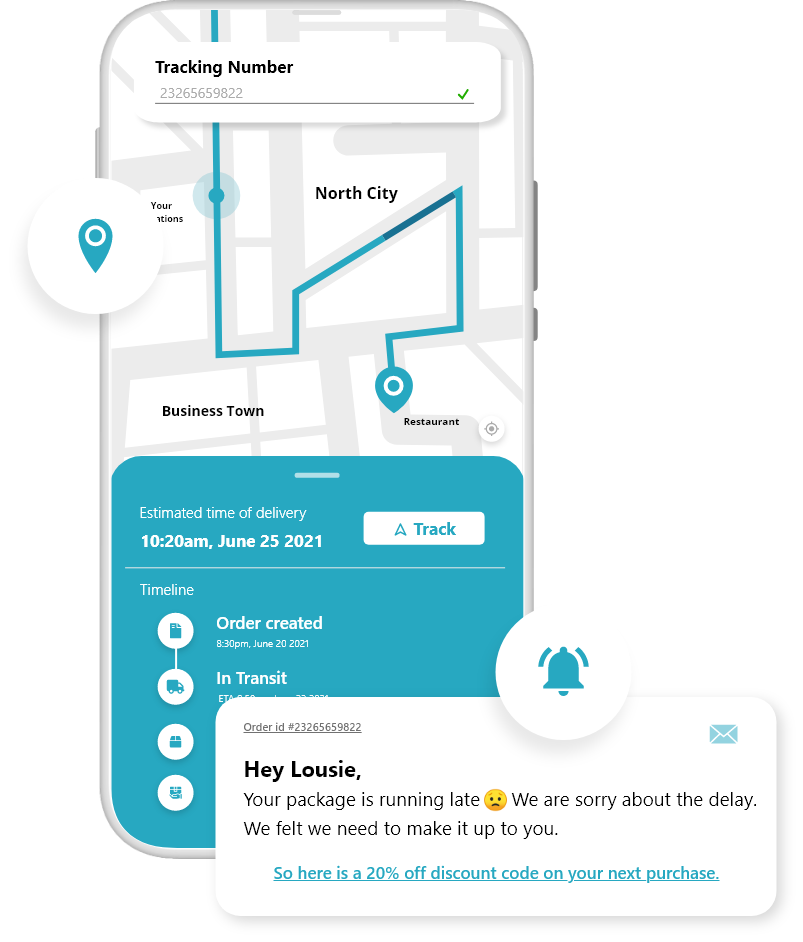Delivery exceptions are unavoidable. Communicate delivery issues and win customer's trust
Turn poor delivery experience into customer success.


Trusted by the worlds leading brands



In the dynamic and intensely competitive eCommerce industry, timely package delivery is one of the most important factors to gain customers’ trust and loyalty.
On the other hand, delivery delays and lack of communication about the order status frustrates customers, and it will not take long for them to discard the seller.
This is why eCommerce stores need to pay attention to manage delivery exceptions if they partner with a shipping carrier like FedEx or UPS for order fulfillment.
By knowing about delivery exceptions you can help your customers to get status updates on their package and reduce their anxiety.
No matter how much you try to streamline your shipping, there could be delivery exceptions, which will delay deliveries.
What is a Delivery Exception?
Simply put, a delivery exception occurs when a package encounters an unexpected situation while in transit that may delay the delivery.
Even a leading shipping carrier that applies the latest technology and process often cannot stop delivery exceptions from happening during the transit.
Often a delivery exception may not mean a late shipment, but due to a certain situation, the shipment may get stalled midway during the journey.
On many occasions, carriers like FedEx and UPS manage to deliver packages despite challenges.
Types of Delivery Exceptions
Here are the most common types of delivery exceptions:
Wrong Address and Damaged Label
Wrong addresses or label damage can cause delivery exceptions. Ecommerce stores need to carefully verify a customer’s address before dispatching a package to avoid this exception.
Even one error in a typo or a number in the house/apartment number or zip code can lead to delivery issues. Carriers often send back packages with incorrect addresses to the dispatch station or the sender.
Loss and Damage
Packages may damage during transit due to accidents, which force the carrier to hold the shipment.
In those situations, the carrier returns the damaged package to the initial dispatch station after attaching a damaged note.
To minimize the risks of damages during transit, make sure that your product packaging is robust. Just like damages, sometimes packages go missing.
When a shipping carrier finds out that a shipment is missing and it can’t be delivered, the customer will receive a loss exception.
Issues with Pickups and Deliveries
Delivery exceptions relating to pick-up happen when the shipping carrier can't locate the delivery address or a pick-up address. In this situation, you need to reschedule another pick-up date and time for the carrier.
Holidays
Exceptions due to holidays are common, particularly during Christmas or New Year. Rush for holiday shopping and huge package volumes often result in shipping delays.
Besides, if a package has any missing information, such as weight, dimensions, labels, there could be further delivery delays.
Reasons for Delivery Exceptions
Accidents
Even when shipping carriers take all the safety measures, accidents might happen. Then the carrier has to hold the shipment.
If an accident causes damages due to a package, the carrier sends it back to the dispatch station with a note.
If the shipping carrier realizes that they cannot deliver a package due to an accidental damage, again the customer receives a loss exception notification.
Customs Delays
During international shipments, delivery exceptions often happen due to customs delays.
If customs hold packages at the airport for longer, it may lead to a delivery exception. To avoid this, you need to have the harmonized codes and documents in place.
Federal Holidays
Delivery exceptions may happen due to federal holidays, either in the country of origin or the destination country while a shipment is in transit.
On the national holidays, shipping carriers remain closed. Due to the day off, there could be further delay since the carrier may want to clear its backlog shipments.
Bad Weather
Harsh weather conditions often make it impossible for a carrier to deliver packages on time. Natural disasters such as tornado, hurricane, earthquake, flood, or wildfire can block a delivery route.
You can work around a roadblock by using multiple fulfillment centers and ship packages from different locations, avoiding the disrupted route. Some carriers have a contingency plan ready to deliver packages through a different route.
Damaged or missing labels
If a package has a damaged or missing shipping label, and the carrier cannot figure out the delivery address or scan the barcode, it could delay delivery. When it is not possible to read or scan important details, an exception code is generated.
How to Handle Delivery Exceptions
When sending out your packages using leading shipping carriers such as FedEx or UPS, on most occasions you will get fast and efficient service.
Both FedEx and UPS deliver more than 98 percent of packages on time. However, unexpected and unavoidable circumstances may result in exceptions.
If you receive notification relating to delivery exceptions, immediately update your customer about the new delivery time of his/her package.
Both FedEx and UPS issue delivery exceptions due to wrong addresses, holidays, missing or damaged labels, customs delays, and others. Different types of exceptions and current protocols are mentioned on the websites of these two shipping carriers.
Delivery exceptions might happen often. However, it should not always be a problem for your eCommerce business. You need to learn how to handle these issues.
You can follow the steps below:
1. Contact the shipping carrier right away
As soon as a delivery exception happens, immediately contact your shipping carrier about the issue and find out where the shipment is stuck. Also, ask the carrier about the best possible way to solve the problem.
2. Update the customer about the package status
Once you come to know about a delivery exception, call or email the customer explaining the problem. If the delivery exception is because of a wrong address, validate it with the customer to fix the issue. Also, apologize to the customer for the inconvenience to pacify the matter.
3. Resend the package or refund the money
If a package could not be delivered due to an exception, you can resend it to the recipient or issue a refund. You can use a good shipping insurance to cover the expenses of refunds and compensate for a package damaged during transit.
Transform poor delivery experience into customer success
Delivery exceptions can disrupt the scheduled delivery time of customer’s packages. However, knowing about them early and acting on them can help you retain customers. Sample this : Sarah orders a pair of pinstripe pants for a business event. Unfortunately, your shipping partner fails to deliver it on time. Sarah is frustrated. If you know about the delay beforehand, you could
- Ship a replacement using overnight delivery
- Ship the package to the event’s destination
- Apologise and Include a discount code for subsequent purchase
Particularly, when the delivery of your packages is time-sensitive, proactively staying on top of orders and having a contingency plan for exceptions is likely to improve your service efficiency and enhance customer satisfaction.

